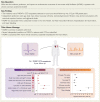New-onset atrial fibrillation and chronic coronary syndrome in the CLARIFY registry
- PMID: 37634147
- PMCID: PMC10834159
- DOI: 10.1093/eurheartj/ehad556
New-onset atrial fibrillation and chronic coronary syndrome in the CLARIFY registry
Abstract
Background and aims: Data on new-onset atrial fibrillation (NOAF) in patients with chronic coronary syndromes (CCS) are scarce. This study aims to describe the incidence, predictors, and impact on cardiovascular (CV) outcomes of NOAF in CCS patients.
Methods: Data from the international (45 countries) CLARIFY registry (prospeCtive observational LongitudinAl RegIstry oF patients with stable coronary arterY disease) were used. Among 29 001 CCS outpatients without previously reported AF at baseline, patients with at least one episode of AF/flutter diagnosed during 5-year follow-up were compared with patients in sinus rhythm throughout the study.
Results: The incidence rate of NOAF was 1.12 [95% confidence interval (CI) 1.06-1.18] per 100 patient-years (cumulative incidence at 5 years: 5.0%). Independent predictors of NOAF were increasing age, increasing body mass index, low estimated glomerular filtration rate, Caucasian ethnicity, alcohol intake, and low left ventricular ejection fraction, while high triglycerides were associated with lower incidence. New-onset atrial fibrillation was associated with a substantial increase in the risk of adverse outcomes, with adjusted hazard ratios of 2.01 (95% CI 1.61-2.52) for the composite of CV death, non-fatal myocardial infarction, or non-fatal stroke, 2.61 (95% CI 2.04-3.34) for CV death, 1.64 (95% CI 1.07-2.50) for non-fatal myocardial infarction, 2.27 (95% CI 1.85-2.78) for all-cause death, 8.44 (95% CI 7.05-10.10) for hospitalization for heart failure, and 4.46 (95% CI 2.85-6.99) for major bleeding.
Conclusions: Among CCS patients, NOAF is common and is strongly associated with worse outcomes. Whether more intensive preventive measures and more systematic screening for AF would improve prognosis in this population deserves further investigation.
Keywords: Atrial fibrillation; Chronic coronary syndrome; Coronary artery disease; Risk assessment.
© The Author(s) 2023. Published by Oxford University Press on behalf of the European Society of Cardiology.
Figures



